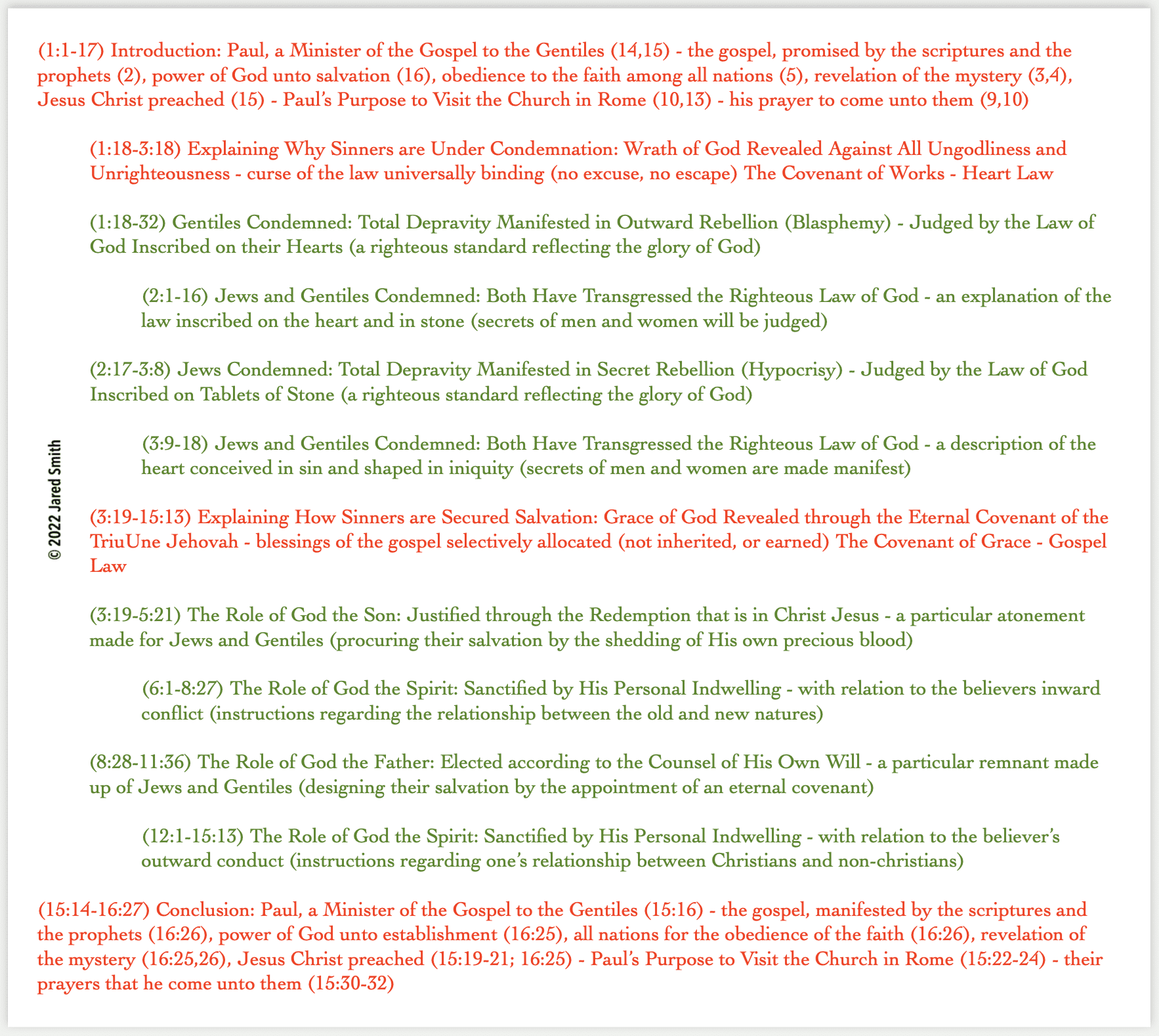17 Bible Doctrine – How Does Paul’s Teaching In Romans 9 Fit Within The Letter To The Romans As A Whole?
A Transcript Of The Video Study
In our previous study, we took a snapshot at how the scriptures use the analogy of a potter and the clay to depict the sovereignty of God and the relatedness of the human race to Him. It was concluded that Paul did not use this analogy carelessly, as if any other comparison would have served his purpose all the same. No, rather, he deliberately chose the analogy because it happens to be one of the clearest descriptions of God’s masterplan for the ages—He is the potter, and we are the clay!
Now, as we have discovered, the main structure of this framework is outlined by Paul in Romans chapter 9. However, this is by no measure apparent to most people who read and study that chapter. In fact, many believe the chapter is a reference to the nation of Israel, whom they interpret to be God’s nationally elect people. Of course, I understand the chapter to be a reference to God’s spiritually elect people, which is clearly outlined on this diagram. And so, the question which should be addressed at this point in our studies is just that—does Romans chapter 9 refer to Israel as God’s nationally elect people, or does it refer to God’s spiritually elect people? To answer this question, we must step back and understand how the chapter fits within Paul’s letter to the Romans as a whole.
The letter has been divided into 16 chapters, and it takes approximately 1 hour to read in a single sitting. That is something I would like to encourage you to do this week—set aside an hour of your time, uninterrupted, and read through the book of Romans. As a guide for your journey through the letter, allow me to give you an overview of the book.
There are four main parts to the letter:
First, Paul opens the letter with an introduction in (1:1-17); Second, he gives an explanation on why sinners are under condemnation in (1:18-3:18); Third, he gives an explanation on how sinners are secured salvation in (3:19-15:13); Fourth, he closes the letter with a conclusion in (15:14-16:27).
Henceforth, there is an introduction and conclusion, with the main body of the letter to be an explanation on sin and salvation. As you can see, there is nothing complex about the content of the book. It is quite simple and straightforward. With these notes alone, you are able to easily navigate through the chapters of the book. However, I wish to highlight a few more things that should prove useful.
For instance, there are some interesting comparisons and contrasts between the introduction and the conclusion.
In the introduction, Paul identifies himself as a gospel minister to the Gentiles (1:14,15); he does precisely the same thing in the conclusion (15:16).
In the introduction, he explains the gospel was promised in the scriptures and the prophets (1:2); in the conclusion, he explains the gospel is manifested by the scriptures and the prophets (16:26).
In the introduction, he points out that the gospel is the power of God unto salvation (1:16); in the conclusion, he adds that the gospel is the power of God unto their establishment in the faith (16:25).
In the introduction, he speaks of obedience to the faith among all nations (1:5); in the conclusion, he speaks of all nations for the obedience of the faith (16:26).
In the introduction, he speaks of the revelation of the mystery (1:3,4); he speaks of the same thing in the conclusion (16:25,26).
In the introduction, he speaks of Jesus Christ being preached (1:15); he speaks of the same thing in the conclusion (15:19-21; 16:25).
And in the introduction, he speaks of his purpose to visit the church at Rome (1:10,13) and his prayer to come unto them (1:9,10); in the conclusion, he also speaks of his purpose to visit the church at Rome (15:22-24), but this time asks for their prayers on his behalf (15:30-32).
Now, there are several other interesting similarities between the introduction and the conclusion, but this should be sufficient to guide your thoughts as you read these portions of the letter. You see, everything Paul writes at the beginning, is repeated and affirmed at the end.
Now, let us look at the main sections of the letter.
As I pointed out earlier, in (1:18-3:18), Paul explains why sinners are under condemnation, whereas in (3:19-15:13), he explains how sinners are secured salvation. Please notice,
In (1:18-3:18), sinners are under condemnation because the wrath of God is revealed from heaven against all ungodliness and unrighteousness of men; whereas in (3:19-15:13), sinners are secured salvation because the grace of God is revealed through the eternal covenant of the TriUne Jehovah.
In (1:18-3:18), Paul explains the curse of the law is universally binding upon the human race—there is no excuse for sin, neither is there an escape from judgment; whereas in (3:19-15:13), he explains the blessings of the gospel are selectively allocated to the elect—these blessings are not inherited, neither can they be earned.
In (1:18-3:18), the authority under which the human race is in relationship to God is the covenant of works, and all unregenerate sinners are duty-bound to God according to the law inscribed upon their hearts; whereas in (3:19-15:13), the authority under which the elect are in relationship to God is the covenant of grace, and all regenerate sinners are duty-bound to God according to the gospel law of life and liberty in Christ.
And so, we have in Paul’s letter to the Romans as a whole, a comprehensive explanation of sin and salvation. Please notice, it revolves around the two perpetual covenants under which the members of the human race are accountable unto God—that of works and grace. Now, if we align the teachings of this letter with the framework of sovereign grace, do you see how it all meshes together? In (1:18-3:18), Paul explains how the human race is in relationship to God under the authority of the covenant of works, whereas in (3:19-15:13), he explains how the elect are secured salvation under the authority of the covenant of grace.
Well, I haven’t finished with the notes. Let’s come back to the main structure of Paul’s letter to the Romans, and take a closer look at Paul’s explanation on why sinners are under the condemnation of God.
There are four parts to this section of the letter:
In (1:18-32), Paul explains that the Gentiles in particular are under God’s condemnation; then, in (2:1-16), he explains that the Jews and Gentiles together are under God’s condemnation; then, in (2:17-3:8), he explains that the Jews in particular are under God’s condemnation; and finally, in (3:9-18), he explains that the Jews and Gentiles together are under God’s condemnation. So, as a whole, the entire world is under the condemnation of God—both Jews and Gentiles. However, because the Jewish people had been singled out by God as a special nation in previous centuries, Paul takes the time to explain that the Jews and Gentiles share the same problem and are under the same condemnation of God’s wrath.
Now, please notice, when Paul explains in (1:18-32) that the Gentiles are under God’s condemnation, he points out that their total depravity is manifested in outward rebellion—their expression of sin came in the form of open blasphemy; whereas in (2:17-3:8), when Paul explains that the Jews are under God’s condemnation, he points out that their total depravity is manifested in secret rebellion—their expression of sin came in the form of hidden hypocrisy.
In (1:18-32), the Gentiles are held accountable and judged by God according to the law He has inscribed upon their hearts—the heart law is a righteous standard reflecting the glory of God; whereas in (2:17-3:8), the Jews are held accountable and judged by God according to the Mosaic law—the Mosaic law is also a righteous standard reflecting the glory of God.
And then, in (2:1-16), when Paul declares that the Jews and Gentles are both under God’s condemnation, he points out that they have equally transgressed the righteous law of God, providing an explanation on the relationship between the heart law and the Mosaic law, asserting that the secrets of men and women will be judged; whereas in (3:9-18), when Paul declares again that the Jews and Gentles are both under God’s condemnation, he points out that they have equally transgressed the righteous law of God, providing a description of the heart conceived in sin and shaped in iniquity, asserting that the secrets of men and woman will be made manifest.
This, then, is the essence of Paul’s explanation on why sinners are under the condemnation of God. The whole section revolves around the unregenerate sinner’s responsibility to God under the authority of the covenant of works.
And so, we come to the final section of the letter, and that which is by far the lengthiest part of the book—Paul’s explanation on how sinners are secured salvation in (3:19-15:13).
There are also four main parts to this section of the letter:
In (3:19-5:21), Paul explains the role of God the Son in the work of salvation; in (6:1-8:27), he explains the role of God the Spirit in the work of salvation; in (8:28-11:36), he explains the role of God the Father in the work of salvation; and in (12:1-15:13), he explains once more the role of God the Spirit in the work of salvation. Henceforth, we have here an exhaustive explanation of the covenant of grace. This whole section revolves around the regenerate sinner’s responsibility to God under the authority of the covenant of grace. Let me remind you, the covenant of grace is an agreement drawn up by the three persons of the Godhead from eternity, whereby sinners are secured salvation according to His sovereign grace. This is why we call it, the covenant of grace, or, the gracious covenant. And, lest there be any confusion on the matter, the gracious covenant is nothing other than the gospel itself. The gospel—the good news of glad tidings—is that the TriUne Jehovah has secured for His elect people salvation through the Lord Jesus Christ, by the effectual power of the Holy Spirit. The gospel begins with the electing love of God the Father, which secures for His elect the redeeming grace of God the Son and guarantees the sanctifying power of God the Spirit. What you see in this diagram, is precisely what Paul is explaining in (3:19-15:13).
Now, let’s look at Paul’s explanation of the covenant of grace a little more closely.
Please notice, in (3:19-5:21), when Paul explains the role of God the Son in the work of a sinner’s salvation, he points out that the sinner is justified through the redemption that is in Christ Jesus. A particular atonement is made for Jews and Gentiles, whereby their salvation is procured by the shedding of Christ’s precious blood. Alright, but who was it that sent the Son to accomplish this work of redemption? Well, that is what Paul explains in (8:28-11:36). This is an explanation of the role of God the Father in the work of a sinner’s salvation. What exactly does the Father do? He has set apart, or elected, a people as special objects of His love according to the good pleasure of His will. This is the election of a particular remnant of the human race, inclusive of Jews and Gentiles, whereby the Father has designed their salvation by the appointment of an eternal covenant. That is, God the Father is the one who took the initiate in the gracious covenant, His electing love being the cause for the Son’s redeeming grace.
And finally, take a look at the last two sections. In (6:1-8:27) and (12:1-15:13), we have an explanation of God the Spirit’s role in the work of a sinner’s salvation. In both sections, Paul explains how the elect sinner is sanctified by the Holy Spirit according to His personal indwelling of the believer, which occurs after the new birth. In (6:1-8:27), the subject of sanctification is considered from the standpoint of the believer’s inward conflict—instructions are given regarding the relationship between the old and new natures residing in the soul. Whereas in (12:1-15:13), the subject of sanctification is considered from the standpoint of the believer’s outward conduct—instructions are given regarding his/her relationship he/she nurtures between Christians and non-Christians. Henceforth, that which comes under the category of what many people call “practical Christianity” is to be found in these two sections of Paul’s letter to the Romans.
Now, there it is my friends! This is the glorious gospel of the blessed God. This is the gospel of our salvation. This is the gospel of grace—the gospel of sovereign grace. This is the gospel of the covenant of grace. And, when you align the teachings of Paul in his letter to the Romans with the framework of sovereign grace, you will discover a perfect harmony between what you see on this diagram, and what you read in the book of Romans. Where does Romans chapter 9 fit within Paul’s letter to the Romans as a whole? It comes under the heading on how sinners are secured salvation, and it specifically fits into the role of God the Father in His work of salvation —it is all about His electing love, setting apart a remnant of the human race as special objects of His love.
Well, as I close this study, may I encourage you to read the book of Romans while using the notes I have provided in this study? Examine the letter for yourself, and see whether the structure I have given for the book is in agreement with your understanding of Paul’s teachings. If you do this, then it will prepare you for our next study, when I will present to you another structure which highlights the role of God the Father in work of our salvation (8:28-11:36). Until then, may God be pleased to open our understanding of His salvation, that we may grow in grace and in the knowledge of our Lord Jesus Christ!
Please zoom in on the photo to read the text. These are the complete notes for the structure of Paul’s letter to the Romans.
Jared Smith served twenty years as pastor of a Strict and Particular Baptist church in Kensington (London, England). He now serves as an Evangelist in the Philippines, preaching the gospel, organizing churches and training gospel preachers.
Jared Smith's Online Worship Services
Jared Smith's Sermons
Jared Smith on the Gospel Message
Jared Smith on the Biblical Covenants
Jared Smith on the Gospel Law
Jared Smith on Bible Doctrine
Jared Smith on Bible Reading
Jared Smith's Hymn Studies
Jared Smith on Eldership
Jared Smith's Studies In Genesis
Jared Smith's Studies in Romans
Jared Smith on Various Issues
Jared Smith, Covenant Baptist Church, Philippines
Jared Smith's Maternal Ancestry (Complete)





